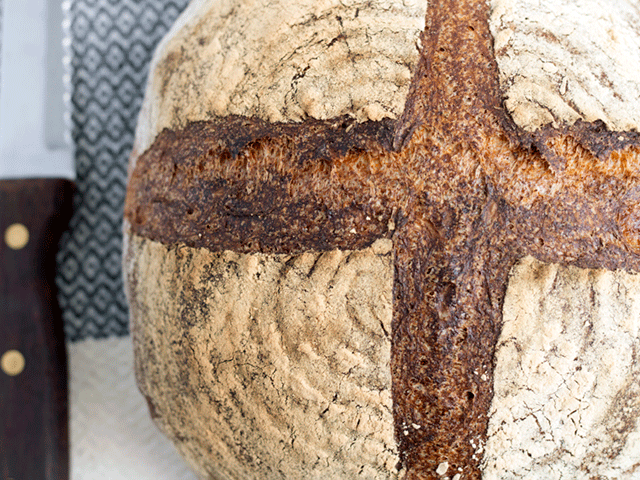
In a rush? You can skip straight to the Same-Day Artisan-Style 75% Wheat Bread recipe at my Tumblr. Or you can jump to my Just the Basics section.
I love trying new recipes. From the fast and easy quick breads to flavorful multi-day sourdough recipes, I take great pleasure in exploring different bread baking techniques. The more I learn about bread, the more I appreciate a loaf well done.
But some days I feel nostalgic, and I can’t help but go back to my favorite recipes again and again. My same-day artisan white bread, for example, is one of my go-to recipes. When I crave a crackling crust and soft interior but I don’t want to wait several days for my sourdough to develop, I choose this yeasted bread.
This week, I’m combining my love for new recipes and my love for old favorites with a same-day 75% wheat loaf.
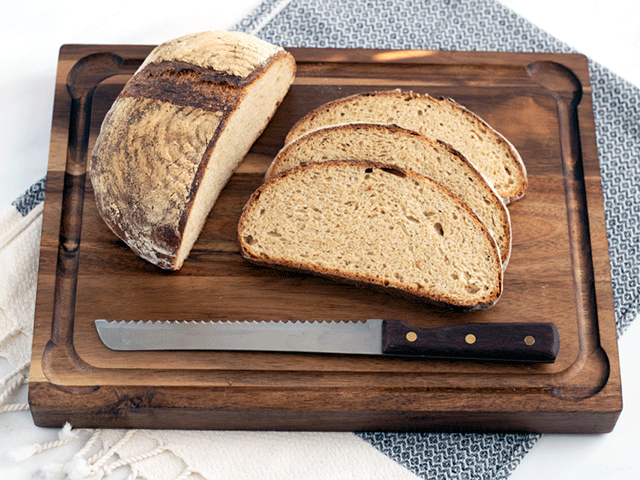
A Great Way to Use Whole Wheat Flour
At home, I grind my own wheat flour. Although small batches of ground flour ensure my bread stays fresh, sometimes I overestimate how much baking I’ll do in the next month. Since I was also strapped for time, I needed a new recipe that would use up my excess wheat flour without taking days to make.
My same-day artisan white bread recipe seemed like a great place to start, as it was an easier recipe that didn’t require an overnight rise. I followed the same timing and techniques as my old recipe, but I swapped out most of the all-purpose flour for whole wheat. And because whole wheat flour tends to be more difficult to work with than all-purpose, I figured I’d make things easy on myself and my fellow bakers by opting for a blend of the two flours.
My baking instincts were spot on with this recipe. Although I had to increase the hydration to account for the whole wheat flour’s drier nature, the resulting bread was just as crispy on the outside and just as soft on the inside as the original loaf.
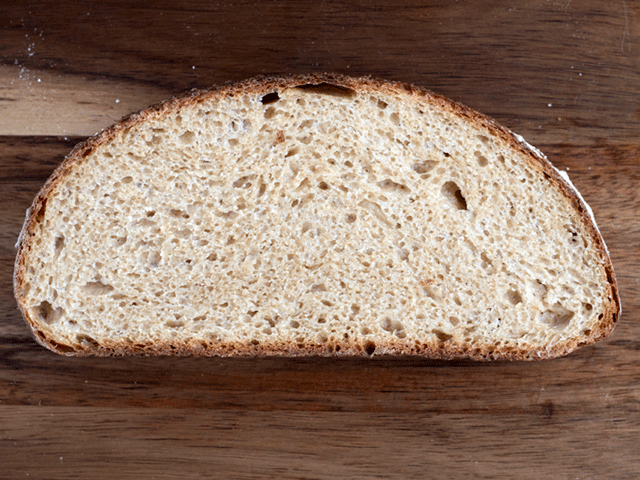
My same-day artisan-style 75% wheat bread recipe is a great choice for beginning bakers. It doesn’t require a sourdough starter, so you don’t have to worry about timing the rise and fall of sourdough. Also, the inclusion of all-purpose flour makes this loaf easier to stretch, fold, and shape than a loaf made entirely of whole wheat flour. Furthermore, the whole wheat flour soaks up a lot of the water, so it behaves like a lower hydration loaf, so you don’t have to struggle with a wet, slack dough.
If you are a fan of whole wheat breads without the fuss, then don’t wait to try this recipe.
Time
Prep time: 15 to 20 Minutes+
Rise time: 4 to 5 Hours
Cook time: 45 Minutes
Total time: 6 1/2 Hours to 7 1/2 Hours
Ingredients
As you prepare to make your bread, make sure you have the following ingredients readily available:
- 375 Grams (2 3/4 Cups + 2 Tablespoons) Wheat Bread Flour*
- 125 Grams (1 Cup + 2 Teaspoons) White Bread Flour*
- 400 Grams (1 2/3 Cup) Warm Water
- 10.5 Grams (1 3/4 Teaspoon) Fine Sea Salt
- 1.5 Grams (1/2 Teaspoon) Dry Active Yeast
*Don’t have bread flour? You can create your own bread flour substitute:
- 356.25 Grams (2 3/4 Cups) Whole Wheat Flour
- 118.75 Grams (1 Cup) All-Purpose Flour
- 25 Grams (3 Tablespoons) Vital Wheat Gluten
I love using vital wheat gluten to give my bread a better texture. However, you can still make this recipe with regular whole wheat flour and all-purpose flour if that’s what you have on hand.
Want to Scale this Recipe?
Here are the baker’s percentages for Same-Day Artisan-Style 75% Wheat Bread:
- 75% Wheat Flour or Wheat Bread Flour
- 25% All-Purpose or Bread Flour
- 80% Water
- 2.1% Salt
- 0.3% Yeast
I know some people struggle with 80% hydration loaves, so feel free to reduce the water to make a bread that’s right for you and your abilities. Just keep in mind that any changes you make will alter the rise times and your dough’s consistency.
Additional Equipment
Artisan-style loaves like this 75% wheat bread require more than your usual bread pan in the oven. Make sure you have these items in your kitchen:
- Kitchen Scale
- Measuring Cups, Bowls, and Spoons
- 4 to 6 Quart Container with Lid
- Bench Scraper/Dough Cutter
- Banneton Basket
- 4 to 5 Quart Dutch Oven
- High-Heat Parchment Paper
- Bread Lame
- Wire Cooling Rack
- Oven Mitts
Of course, you don’t have to have these items exactly. If you’re resourceful, you can make a few substitutions and still make great bread. For example, I’ve provided volume measurements in addition to weight measurements so you can skip the kitchen scale. Similarly, if you don’t have a Banneton basket, you can use a small bowl lined with linen. Or, if you don’t have a bread lame, a sharp knife or razor will do in a pinch.
As an Amazon associate, I do earn a small commission from affiliate links. But my opinions are my own, so I only recommend products I enjoy and use regularly.
Instructions
Same day artisan-style 75% wheat bread skips the fuss that comes with a sourdough loaf. Rather than timing a starter, just sprinkle some commercial yeast over the dough and you’re good to get baking.
But as with many bread recipes, timing the rise will affect the texture and elasticity of your dough. If your bread rises for too long, it will go flat. If your bread doesn’t rise long enough, it will lack flavor and structure.
I did my best to make the timing process as simple as possible with a sample schedule. However, feel free to start sooner or later in the day to better fit your needs.
10:00 AM – Autolyse the Dough
In a large bowl or container, hand mix the flours and water until you have a loose shaggy dough. Don’t worry about kneading or developing any gluten just yet. If you’re worried about dough sticking to your hands, wet your hands with water prior to mixing and use a spoon to scrape any residual dough clinging to your fingers back into the mix.
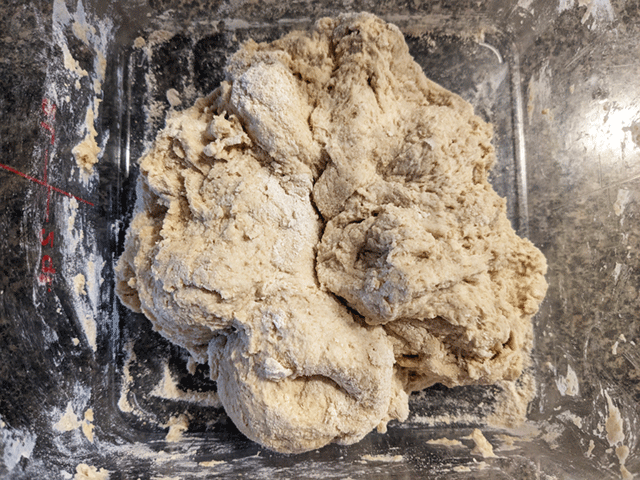
Cover and let rest for one hour.
11:00 AM – Add Salt and Yeast to the Dough
A lot of artisan-style recipes recommend keeping salt away from your yeast, as too much salt can slow or even kill your yeast. However, this recipe uses commercial dry yeast, and everything gets mixed together without any fuss. Just sprinkle both your salt and your yeast over the top of your dough, and then wet your hands to pinch, stretch, fold, and squish the dough to fully incorporate the new ingredients.
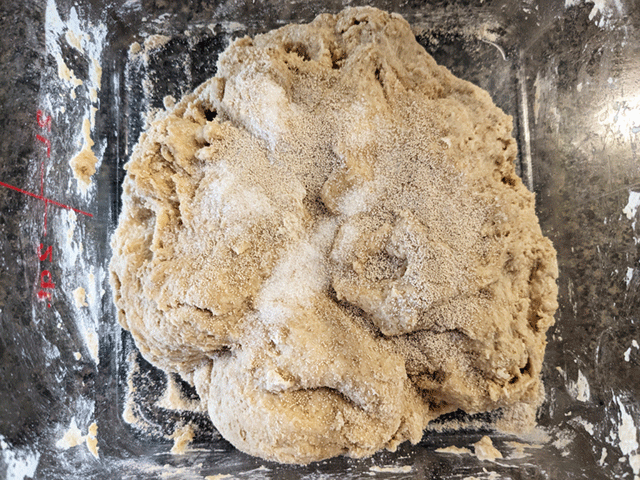
Cover and let rest for 30 minutes.
11:30 AM – 12:30 PM Stretch and Fold the Dough
If you make a lot of bread, you may feel tempted to knead your dough to develop gluten and give your bread better structure. Not so with this 75% wheat bread!
Instead of kneading, you’ll stretch and fold the dough. Grab a corner of the dough and pull it upward until the dough resists without breaking or snapping.
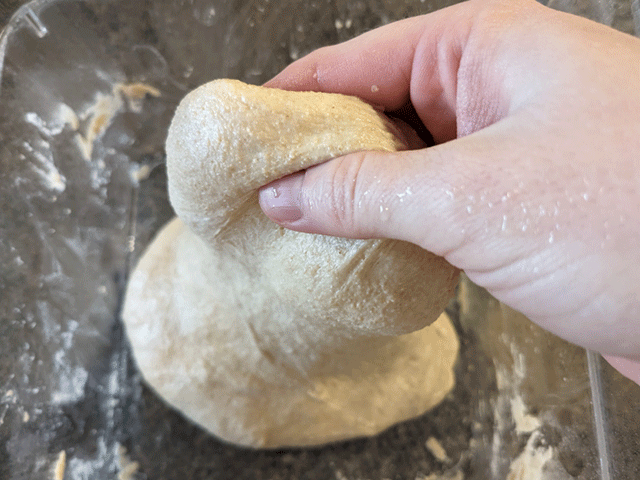
Fold the stretched portion of dough over the top of the rest of the dough.
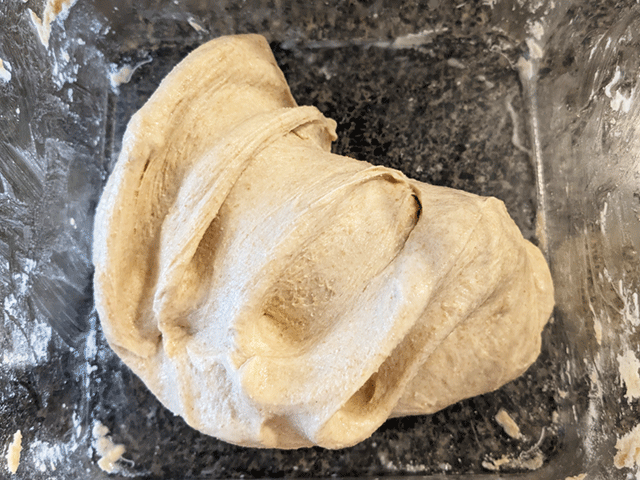
Next, rotate your container, grab another dough “corner,” and stretch and fold the new section. You’ll repeat this stretch and fold technique until the dough tightens and looks a bit like a round.
Cover and let your dough rest 30 minutes. The dough will relax into itself and it will be ready for another stretch and fold session. When you’ve finished, cover and let the dough rest again for 30 minutes, and repeat for one last stretch and fold session. After you’ve finished stretching and folding, your dough will have been stretched and folded 3 total times.
12:30 PM – 2:30 PM – Bulk Fermentation
Fermentation is my favorite part of making 75% wheat bread. All you have to do is let the dough sit and do its thing in a covered container so it doesn’t dry out. I found that I achieve the best results when I’ve let the dough rise about 2 hours. The dough will look puffy, and it will have plenty of air bubbles.
As with most bread recipes, your kitchen temperature will affect rise times. In general, you’ll need to have a kitchen temperature of 68 to 72 degrees Fahrenheit (20 to 22 degrees Celsius). Colder temperatures need more time to ferment, while warmer ones will need less time. If you’re not sure about your current temperature, you may want to invest in a thermometer so you can achieve consistent results.
2:30 PM – 2:45 PM – Pre-Shape and Shape Dough
If you don’t have experience shaping higher hydration bread doughs, this next step may be a bit difficult for a beginner. Fortunately, even if you mess up a bit, your bread will still taste amazing – so don’t panic.
Gently turn your dough out onto a lightly greased surface. It’s okay if your dough deflates a little, but try not to knock out too many of those air bubbles that your dough accumulated during fermentation.
Slide your bench scraper underneath your dough.
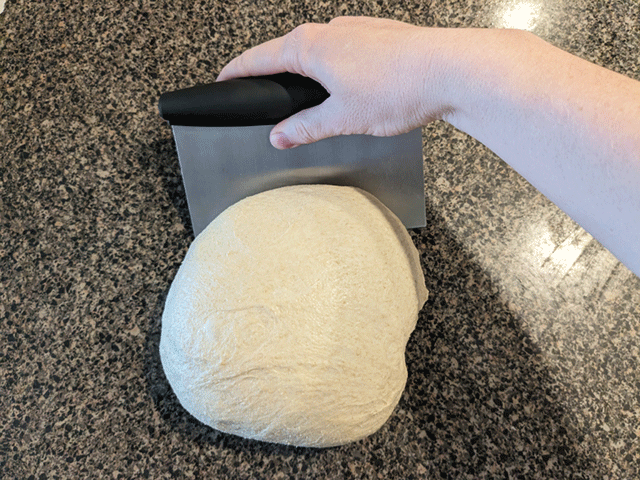
Then turn your scraper in much the same way you’d turn a steering wheel. At the end of the turn, push slightly into the dough to create some tension without tearing or breaking the dough’s skin.
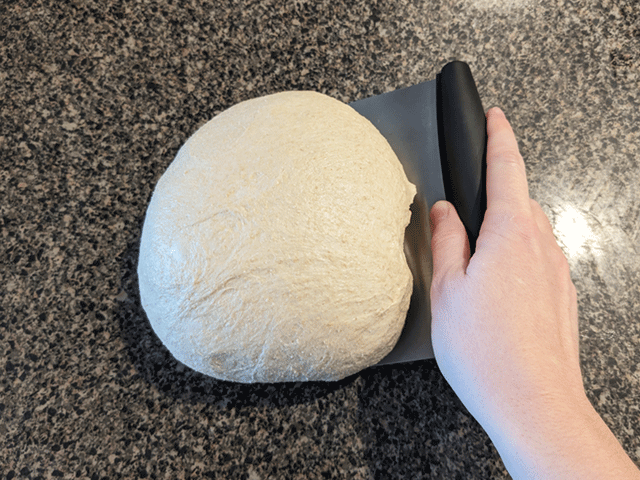
Continue to slide, turn, and push around the edges of the dough until it turns into a round. Try to work quickly to keep the dough from sticking to your bench scraper. If it seems especially sticky, feel free to wet the scraper with water.
Flip your container or bowl upside down and use it to cover your dough so it doesn’t dry out. Let it rest for 15 to 20 minutes, and the dough will relax somewhat after its initial shaping.
When you’re ready for the final shape, repeat the same technique: slide, turn, and push around the edges of your dough until it creates a round.
2:45 PM – 3:30 PM – Proof in the Banneton Baskets
When you have a nice, tight round of dough, generously flour a banneton basket. If you plan on scoring a fancier pattern into your dough later, use a linen liner. If you like the natural swirl pattern from the basket, go ahead and slide your bench scraper under your dough and flip your dough into the basket seams side up.
Accidentally place your dough seam side down? Don’t worry – the dough will naturally split along the seams during baking. This can create a rustic look in your bread, though it will interfere with any scoring you may attempt later.
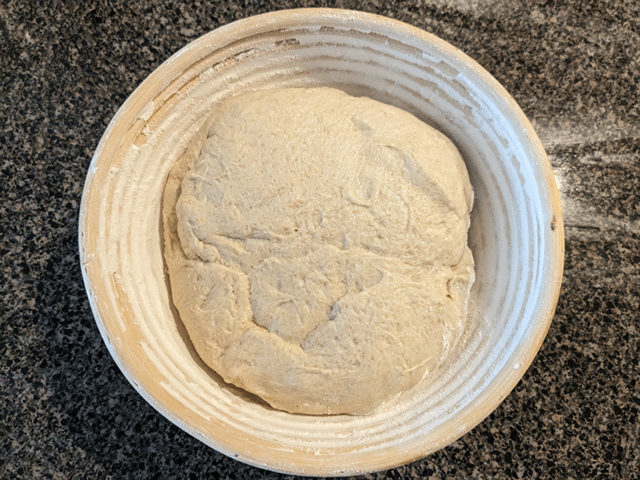
Cover your dough and basket and let it proof for 45 minutes to 1 hour. The dough will rise and become puffy. Keep in mind that it’s easy to over-proof your dough during this second rise, so watch it close.
3:30 PM – 5:00 PM – Preheat Your Dutch Oven, Score, and Bake
Now that your dough is in its second rise, it’s time to preheat your Dutch oven. Place your Dutch oven with its lid inside your oven and preheat the temperature to 475 degrees Fahrenheit (246 degrees Celsius). Ideally, your Dutch oven will have at least 45 minutes to 1 hour to fully heat.
When your Dutch oven has heated and your dough has risen, you can score your dough. Flip your dough out onto a piece of high-heat parchment paper. If your seams were facing up in the basket, they’ll now be on the bottom. If your seams were facing down, your seams will be on the top.
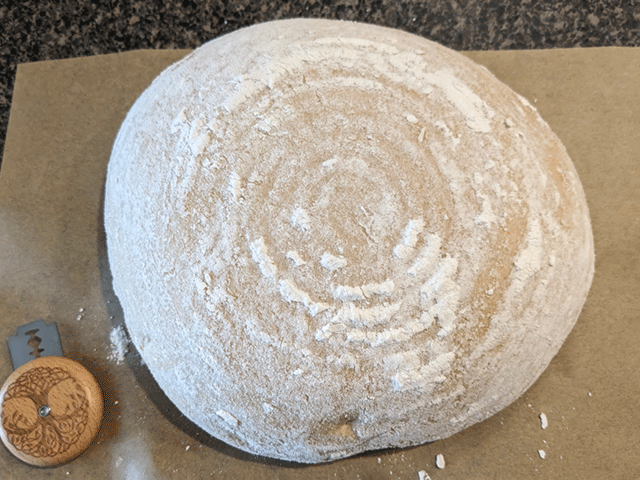
Seam-side down dough will need some simple scoring to open up the loaf and allow for better oven spring. Seam-side up dough will split naturally along the seams and you can skip the scoring stage.
Grab a bread lame (a sharp knife or razor blade will work too), then make deep slashes in your dough. This particular dough can be a bit difficult to score, so try to keep things simple. A cross, hatch, or single slash tend to yield best results.
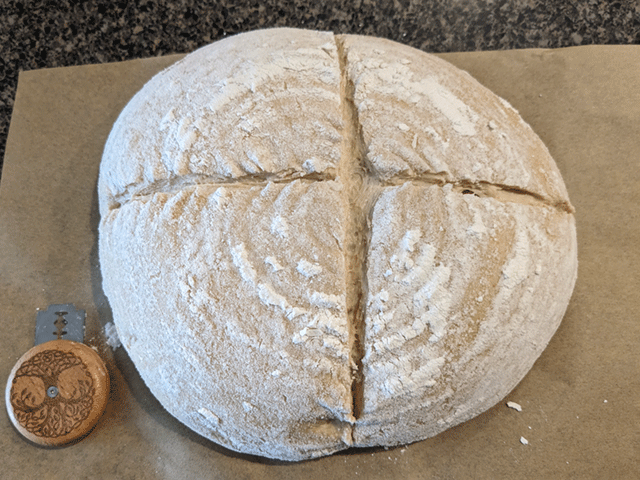
Grab the parchment paper and transfer your dough to your preheated Dutch oven (Careful! the Dutch oven will be hot).
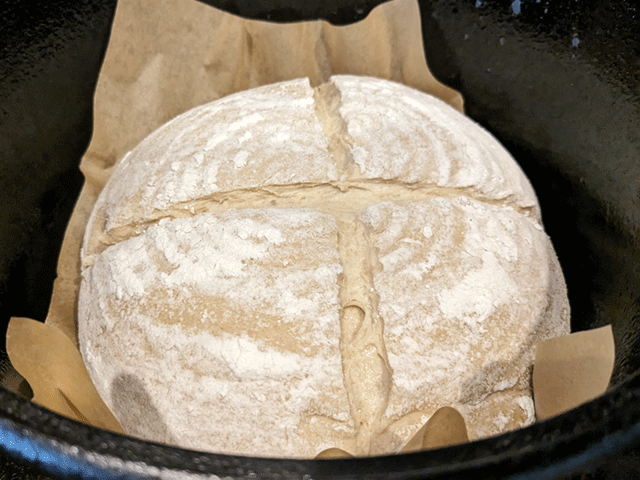
Cover your dough with the Dutch oven lid and put everything in the oven 30 minutes at 475 degrees Fahrenheit (246 degrees Celsius).
After 30 minutes, remove the Dutch oven lid. Your 75% wheat bread will have sprung up in the oven, and it will have a nice golden color. But it’s not quite done yet!
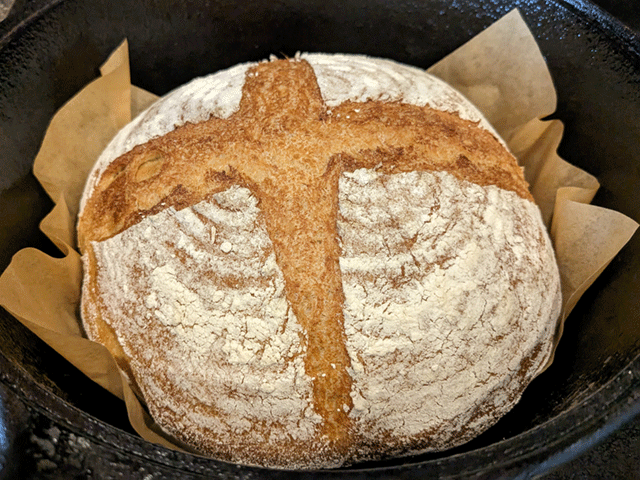
Continue to bake without the lid for an additional 10 to 15 minutes. The crust will darken and achieve a deep rich brown color. If you want your crust to have the most flavor, bake until the loaf looks just shy of burnt. The bottom of your loaf will sound hollow when thumped, and if you have a probe thermometer, the internal temperature will read above 190 degrees Fahrenheit (87 degrees Celsius).
Turn the loaf out onto a wire cooling rack to finish cooling before cutting and serving. Keep in mind that the 75% wheat bread will finish baking with its residual heat from the oven. If you cut into the loaf prematurely, the bread may have a gummy texture.
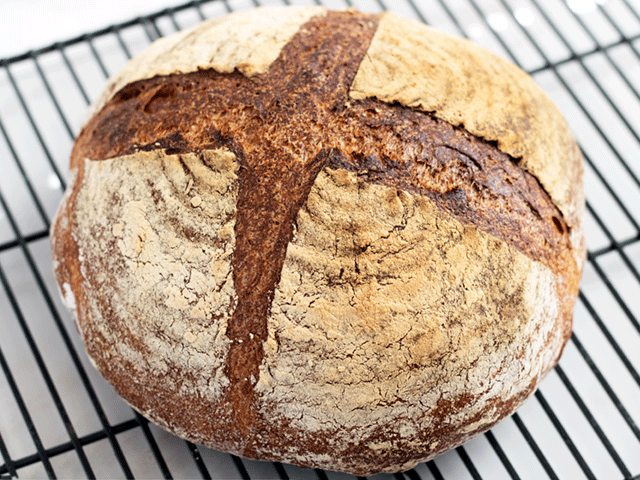
Well done! You’ve just made same-day artisan-style 75% wheat bread. Go ahead and enjoy your lovely loaf.
When stored at room temperature, your bread should last about 3 to 5 days. If you need your bread to last longer, consider freezing (not refrigerating) your bread. Refrigeration makes your bread go stale faster.
Just the Basics

Same-Day Artisan-Style 75% Wheat Bread
Ingredients
- 375 Grams Wheat Bread Flour (2 3/4 Cups + 2 Tablespoons)
- 125 Grams White Bread Flour (1 Cup + 2 Teaspoons)
- 400 Grams Warm Water (1 2/3 Cup)
- 10.5 Grams Fine Sea Salt (1 3/4 Teaspoon)
- 1.5 Grams Dry Active Yeast (1/2 Teaspoon)
Instructions
- 10:00 AM – Mix flour and water by hand in plastic container until just incorporated. Cover and let rest for 1 hour.
- 11:00 AM – Add salt and yeast and mix thoroughly. Cover and let rest for 30 minutes.
- 11:30 AM – 12:30 PM – Stretch and fold the dough three times with 30 minute rests between each session.
- 12:30 PM to 2:30 PM – Bulk ferment the dough until it has doubled in volume.
- 2:30 PM to 2:45 PM – Shape and pre-shape the dough into a round.
- 2:45 to 3:30 PM – Transfer dough to a floured banneton basket. While the dough proofs, preheat the Dutch oven in the oven to 475° Fahrenheit (246° Celsius).
- 3:30 PM – 4:00 PM – Turn the dough out onto parchment paper. Score the dough, and transfer the dough to the Dutch oven. Replace lid and bake for 30 minutes.
- 4:00 PM – 4:15 PM – Remove lid from Dutch oven, and bake for another 15 minutes.
- 4:15 PM – 5:00 PM – Turn loaf out onto a wire cooling rack and allow it to cool completely before slicing and serving.
Notes
Secrets to Success
Same-day artisan-style 75% wheat bread is the perfect recipe for beginner bakers who want to try their hand at artisan-style loaves. It doesn’t require a sourdough starter, so it doesn’t need to be made at peak rise times. However, this recipe still uses yeast, and yeast can be finicky to get right. How you shape and time your bread will affect your final bake.
Here are some pointers to make your first loaf (and successive loaves) even better.
First, get messy!
This dough is sticky and clumpy, but don’t be afraid to get in there with your hands. Wetting your hands with water can reduce the amount of dough that sticks to your fingers, but it won’t eliminate it entirely. For a good loaf, you need to get a feel for good dough.
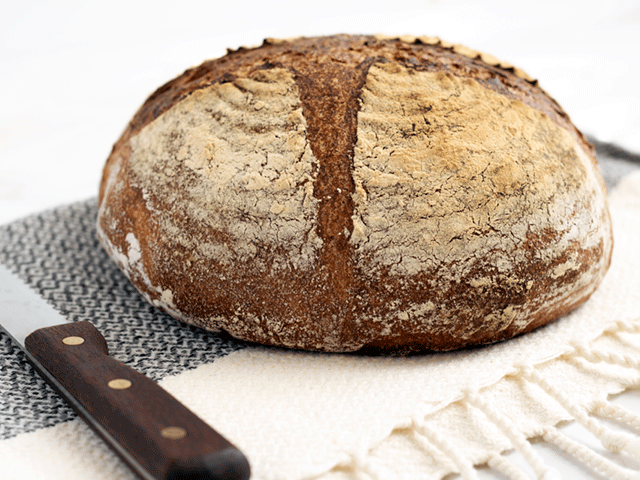
Second, don’t use too much flour during shaping.
After that second rise, any additional flour won’t have time to fully absorb into your dough, resulting flour clumps. If you struggle with your dough sticking to your surface, use a light coating of spray butter or grease.
Third, take notes.
I did my best to perfect the timing for this recipe. However, my timing works best in my kitchen where I’m familiar with the ambient temperature of my house and the temperature of my oven. Your house may have varying temperatures that will affect how you time your 75% wheat bread. As you bake, take notes to see what worked best for you. Don’t forget to include any changes to the recipe, such as greater (or less) hydration and longer (or shorter) rise times.
Nutritional Information
This 75% wheat bread comes with plenty of fiber thanks to the whole wheat flour. Here’s a quick glimpse at the nutritional information of this bread.
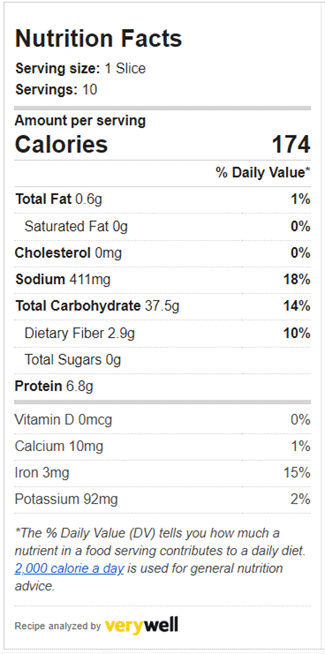
As you track calories, keep in mind that this label is an approximation of serving sizes. Because of its round shape, the slices in the middle will be larger than the slices on the end. Bigger pieces will have more calories per slice than smaller ones.
Did You Try It?
I love hearing about how my friends and family tried my latest recipes. It makes my day to see comments from users about how much fun they had while baking my 75% wheat bread.
But I also want to improve my baking skills, and your feedback is crucial for this process. If you have tips for making this recipe even better, feel free to leave a comment in the section below. If you enjoyed my recipe, don’t forget to share the link with others and leave a star-rating to spread the word about my blog.

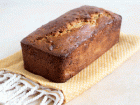
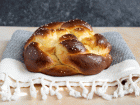
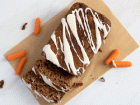
I was wondering how high your final bread is? I can’t get mine higher than 3.5”
That is a good question Liz! This is a loaf with a high percentage of whole wheat flour, so it’s more difficult to work with. I personally haven’t measured my breads’ cross sections before, so I’m not entirely sure how big the middle gets. 3.5 inches seems pretty good though? I’ll have to make this loaf again soon and I’ll let you know my results.
Thanks Jenni. I forgot to feed my sourdough starter and needed some bread that I could make quickly. This made a fantastic and easily made loaf of bread. It rose really well and has a great crust. Your instructions and guidance were spot on!
I’d upload a photo if I could.
Yay! I’m so happy to hear that. Thank you so much for the kind words and positive feedback.